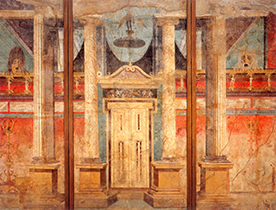 1
1Introduction
The House as Theatre examines the thesis that ancient Graeco-Roman stage scenery influenced the development of Romano-Campanian domestically located wall-painting and in this context it evaluates the legitimacy of using them to reconstruct ancient stage scenery. We know from Aristotle's Poetics that as early as the 4th Century BC. “Three actors and scene-painting Sophocles introduced.” Therefore, it would seem a distinct possibility that some form of overlap may have occurred between in-house wall-painting and theatre ‘scene-painting’ (Aristot. Poet. 1449a).
The Augustan architect and military engineer Marcus Vitruvius Pollio suggested a slightly earlier date when he attributed to Agatharcus not only scene-painting, but also the introduction of fixed point perspective to create the illusion of depth on a flat surface (Vitru. 7.0.11). Plutarch also made reference to a painter named Agatharcus who was lured to the house of Alcibiades and detained there for three months until he completed a series of wall-paintings (Plut. Alc.16). If they were the same artist this would have provided a tangible connection between stage ‘scene-panting’ and domestic wall-painting. Unfortunately, the evidence, mostly provided in terms of different dates and place of origin, suggests that they were not the same person.
< see Agatharchus >
Since the early twentieth-century several historians have pursued the thesis that ancient wall-paintings depicting large-scale architectural facades, such as those that define the Pompeian 'Second' or ‘Architectural’ Style, are either copied or derived from the ancient Roman theatre (fig.1). As such, they are thought to provide legitimate evidence for reconstructing its scenery for which there is scant visual evidence. That which does exist is mainly found in the form of depictions of stage-like structures on ancient vases and terracotta tablets (fig. 2-6). As a result several publications attempted to reconstruct tragic, comic and satyric scenery based on visual elements taken from Second Style wall-painting. Examples of invented stage sets appeared in A.M.G Little's 1936 article Scaeonographia and H. G. Beyen’s monumental two-volume work Die Pompejanische Wanddekoration vom Zweiten bis zum Vierten Stil published in 1938 (fig.7&8). In some cases the illustrations were used to construct actual stage scenery for modern performances of Graeco-Roman dramas. According to the theatre historian Margaret Bieber, A.G.M. Little used… “stage settings in imitation of Pompeian wall painting”, for his 1936 and 1939 Harvard University productions of Alcestis (Euripides); Clouds and Birds (Aristophanes); and Mostellaria (Plautus) - (Bieber 1972 : 454-456).
 1
11 Villa P Fannius Synistor triclinium west wall (c.50 BC)
2 South Italian comedy - actors appearing to parody the myth of Apollo healing Chiron the centaur. Red figure bell-krater, British Museum
3 Orestes and Pylades meeting Iphigenia in Tauris, Louvre Museum
4 Orestes and Pylades meeting Iphigenia in Tauris (detail)
5 Apulian Bell-Krater - actors performing the birth of Helen emerging from an egg. Museo Archeologico, Bari, Italy
6 Actors performing in front off a colonnaded three door stage facade - painted terracotta panel
7 Drawn reconstruction (detail) by A.M.G. Little of an ancient stage set, based on various Romano-Campanian wall-paintings
8 Drawn reconstruction (detail) by H.G. Beyen of Apaturius's design for a stage set as described by Vitruvius in his Ten Books on Architecture (c.20 BC), combined with details taken from various Romano-Campanian wall-paintings.
|